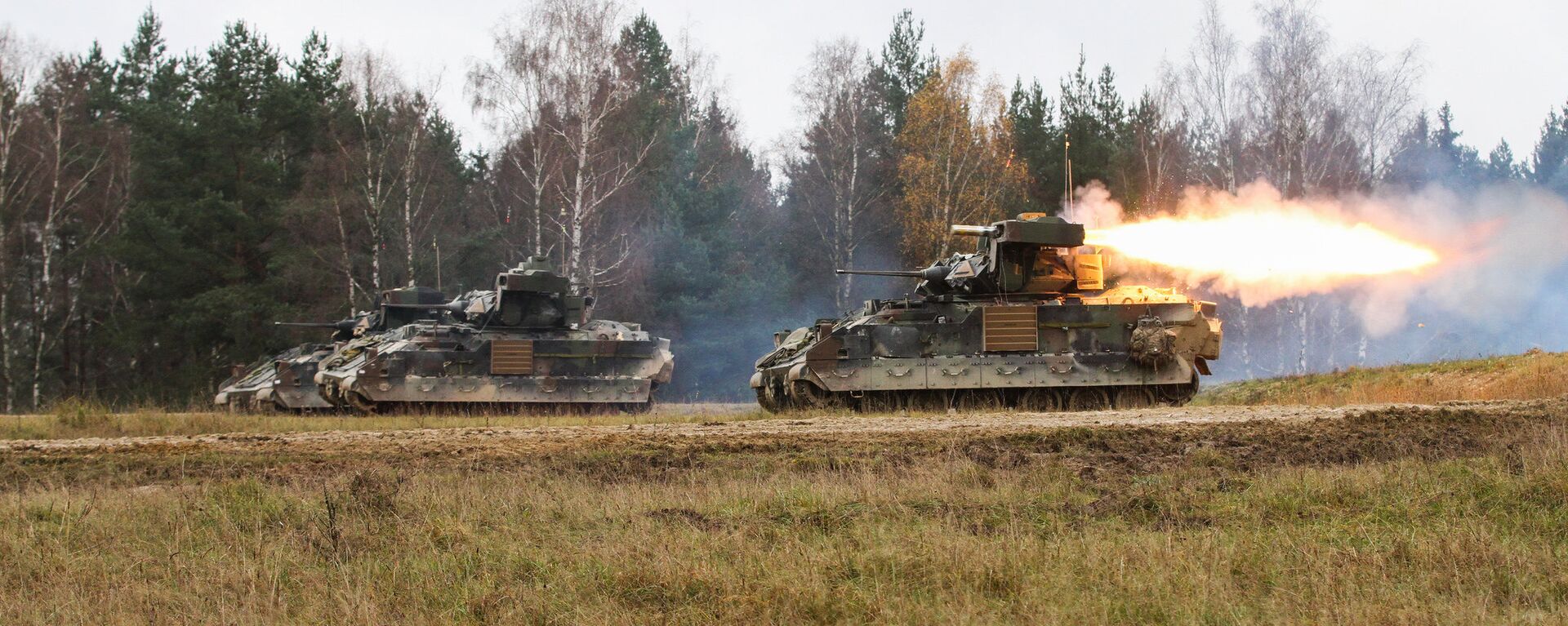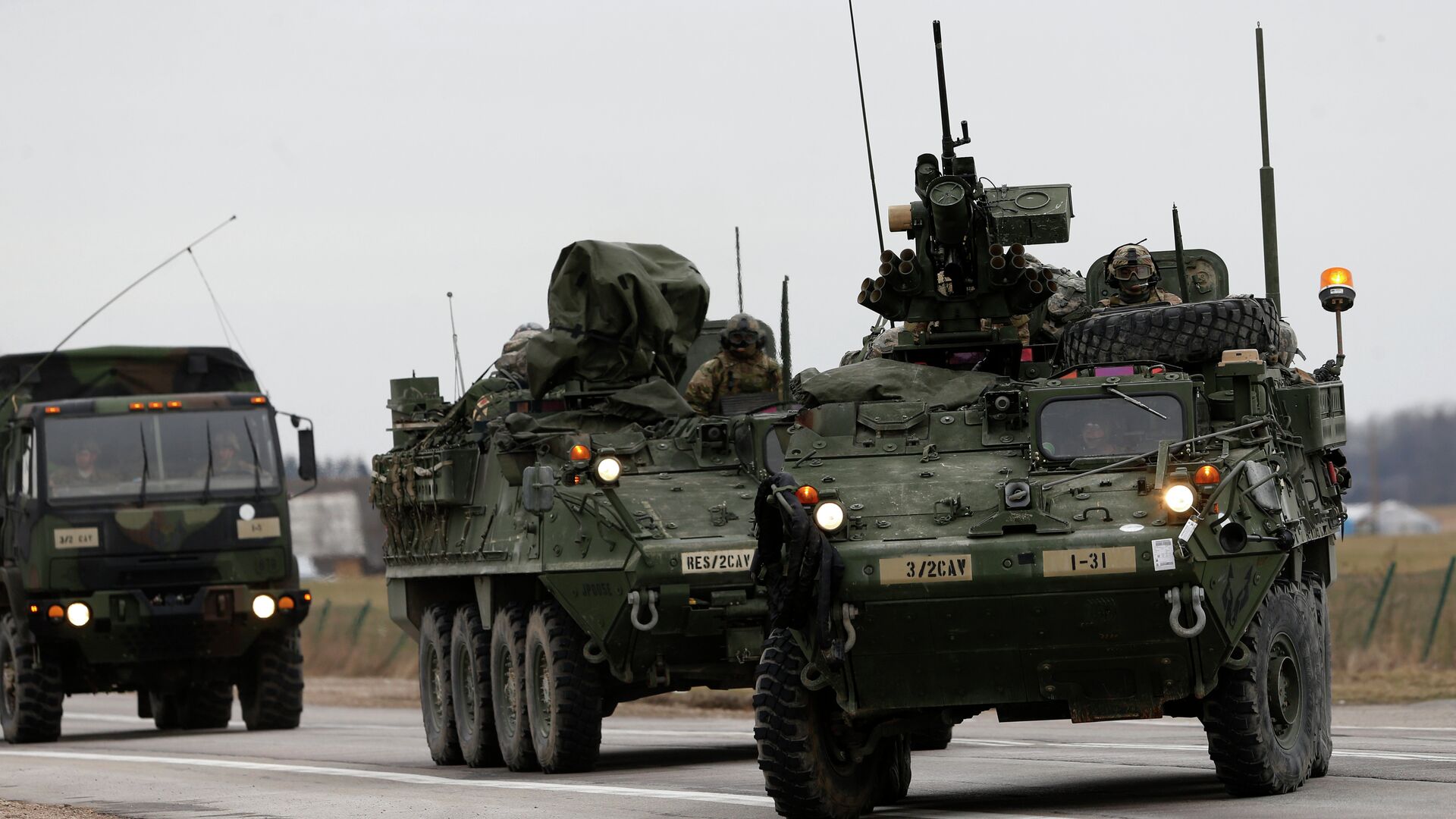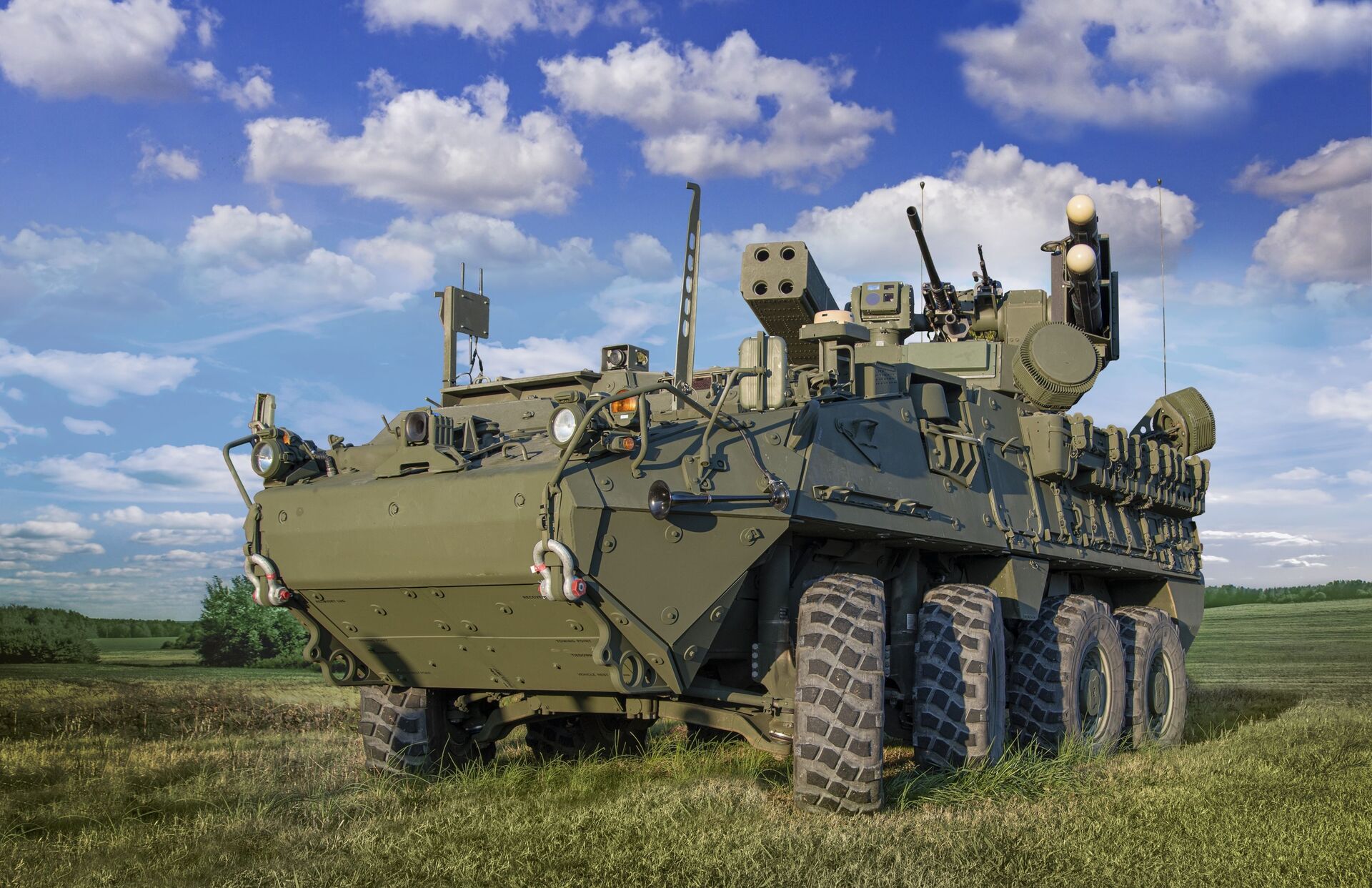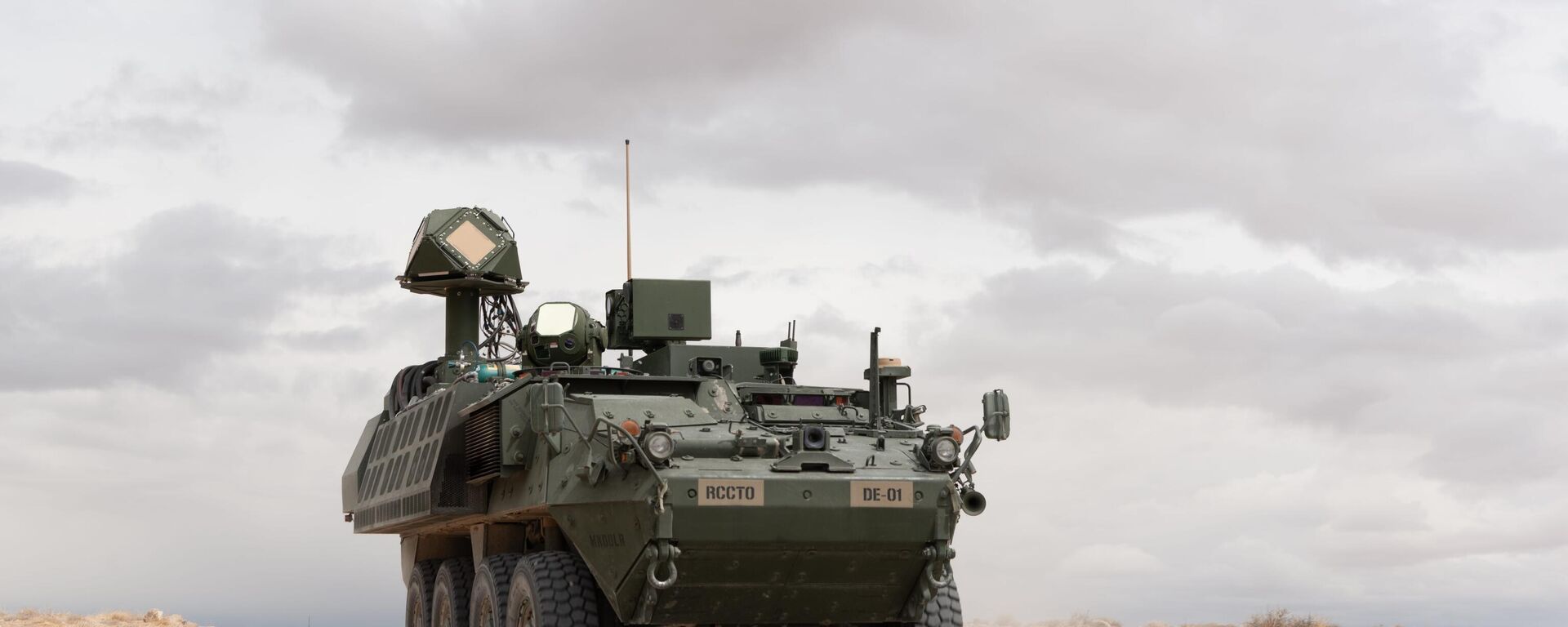https://sputnikglobe.com/20230120/fearsome-fighting-machine-or-dangerous-deathtrap-what-is-the-stryker-afv-us-is-sending-kiev-1106529932.html
Fearsome Fighting Machine or Dangerous Deathtrap: What is the Stryker AFV the US is Sending Kiev?
Fearsome Fighting Machine or Dangerous Deathtrap: What is the Stryker AFV the US is Sending Kiev?
Sputnik International
The Biden administration authorized another $2.5 billion in military assistance to Ukraine on Thursday, including 90 Stryker armored fighting vehicles (AFVs). What are the Stryker’s origins? Where has it fought? Sputnik explores.
2023-01-20T14:50+0000
2023-01-20T14:50+0000
2023-07-31T17:03+0000
russia's special operation in ukraine
us army stryker
iav stryker
strykers
us military
delivery
assistance
aid
armored vehicle
https://cdn1.img.sputnikglobe.com/img/102017/05/1020170579_0:122:4944:2903_1920x0_80_0_0_0604b448a0ef8d1062e991b499251679.jpg
Wheeled and tracked armored fighting vehicles are a mainstay of the vast majority of the world’s armies, with even smaller powers like Belgium, Finland, Myanmar, and Pakistan producing domestically made AFVs featuring armored hulls and at least one piece of onboard weaponry – whether that be a machinegun or anti-tank gun.What are Armored Fighting Vehicles?The United Nations Register of Conventional Arms designates AFVs as vehicles which feature armored protection, can carry four or more infantry, onboard weapons with a caliber of at least 12.5 mm, and/or a missile launcher.At its core, the concept of the AFV goes back to the siege engines of antiquity, when armies would use a combination of wood and iron armor plating to erect great mobile vehicles to protect soldiers from enemy arrows, swords, cavalry, and other dangers. The Ancient Greeks famously used large, multistory "Helepolis" (lit. "Taker of Cities") siege towers fitted with iron plating against enemies on land and at sea going back to at least to the year 305 BC.The AFV concept was elaborated on using horse and elephant-powered vehicles and, with the advent of the petrol engine, became the prototype of the AFVs we know today, with the earliest battlewagons created in the late 1800s, and used in limited numbers during the First World War.It would be during World War II that the modern AFV – i.e. a dedicated armored vehicle for troop carrying with heavy onboard weapons, was born. All the major powers had their own take on AFVs, whether the Soviets with their GAZ BAI-M and BA-64 series armored vehicles, fitted with machine guns, Nazi Germany and its Sd.Kfz. 4 and Sd.Kfz. 250 multipurpose half-tracks, or the US with its M8 Greyhounds and M3 Gun Motor Carriages.What is the Stryker AFV? Who Makes and Uses Them?The Stryker constitutes a series of customizable armored fighting vehicles manufactured by General Dynamics Land Systems-Canada in the province of Ontario. The AFVs can be equipped with an array of weapons, from machine guns and missiles to anti-drone lasers. They have a crew of two, can carry up to nine servicemen, and feature armor protection designed to withstand 14.5x114mm heavy machinegun fire and fragments from indirect fire.Strykers come in several main armament configurations – one with a heavy 105 mm M68A2 gun (the US Army scrapped this variant in 2021), another with a 30 mm MK44 Bushmaster II gun, a third with a 40 mm MK 19 grenade launcher, and fourth variant with a 12.7 mm machine gun. Secondary weapons can include 12.7 M2 Browning and 7.62 mm M240 machineguns.The Stryker is built on the basis of the LAV (Light Armored Vehicle) platform – a late Cold War design which began to be fielded with the US and Canadian armies in the 1980s and early 1990s, and which was, in turn, a deep modernization of the Piranha – an AFV manufactured Swiss defense company MOWAG from the 1970s onward. Originally named the Interim Armored Vehicle (IAV), the Stryker was bestowed its current name in honor of Stuart and Robert Stryker – a pair of unrelated US Medal of Honor recipients who died in World War II and Vietnam.The US and Thailand are currently the Stryker’s only operators. The United States has over 4,450 Strykers spread across nine brigades in its Army and National Guard inventory, while Thailand, which purchased its Strykers second-hand between 2019 and 2021, has 130.How Does the Stryker Differ From Other NATO Armor Sent to Kiev?The Stryker differs from the majority of the heavy NATO kit sent to Ukraine to date in that it is a product of the post-Cold War era, introduced with the US military in 2002, at the dawn of America's "War on Terror."The system was created specifically for nimble, rapid deployment missions to far-flung conflict zones across the globe, with the US Army outlining that a Stryker Brigade Combat Team consisting of 3,500-4,000 troops must be deployable anywhere on the planet within 96 hours.What’s Wrong With the Stryker?Strykers had critics on edge even before seeing any combat. In 2002, on the eve of deployment, the Army was forced to defend the $8 billion+ weapons platform against criticism from Congress that the systems were effectively undeployable using widely available C-130 Hercules turboprop transport aircraft. The issue would plague the AFV for years, with the Government Accountability Office calculating in 2004 that a C-130 with a single Stryker onboard couldn’t travel more than 1,000 km.As the 2000s wore on and US forces got bogged down in Afghanistan and Iraq, other flaws quickly began to be noticed – including sensitivity to rocket-propelled grenades, the need for constant tire pressure checks due to weighty armor, poor handling and performance capabilities in rainy and muddy weather and in urban areas, and strain on the Stryker’s Caterpillar C7 engine, drive shaft, and differentials. The Army also found "design and functionality shortfalls" with the AFV's commanders' display units, weak gunner’s hatch armor, slow, easily overheating computers, a grenade launcher that doesn’t operate properly when the Stryker is on the move, vulnerability to landmines, and issues with troops in heavy gear being unable to fasten their seatbelts, increasing the risk of deadly incidents in case of rollover.These problems, combined with the Strykers’ bulky 7x8 meter silhouette, led to numerous Strykers being lost – including six in a single particularly bloody week in Sadr City, Baghdad in the spring of 2008. Similar problems were reported in Afghanistan, where the system’s armor design failed to provide adequate protection against roadside bombs and RPGs.The Pentagon publicly dismissed the problems at the time, expressing "great pride" in the systems and assuring that the military was "absolutely enthusiastic about what the Stryker has done" for US operational capabilities in Iraq.Privately, however, the number of reported problems continued to mount – among them issues with the weapons platform’s slat add-on armor.What Did Skeptics Say About Strykers’ Prospects Against Russian Tanks?In 2017, as the military proposed stationing Strykers fitted with 30 mm cannons in Europe for possible battlefield deployment against Russia, US Army Maj. James King, an analyst at West Point, warned that the platform would be outgunned by Russian BTR armored transports, and that doctrinally, the systems were "not designed to maneuver against other combat vehicles."The US ignored Maj. King's advice, fitting units of the US 2nd Cavalry Regiment in Europe with 30 mm autocannons and dubbing them Dragoons.In 2018, the Pentagon’s Office of the Director of Test and Evaluation reported new problems with the platform – vulnerability to cyberattacks potentially affecting their data-sharing, GPS navigation, and communications systems.In one particularly ruthless report in 2021, Responsible Statecraft author Mark Perry slammed a $1 billion Stryker modernization program, citing many of the above-mentioned issues and dubbing the vehicles a “deathtrap” and their upgrade little more than a plot to “pad the pockets of an American defense contractor.”Wear-and-tear issues have also reportedly plagued the system, with Strykers involved in live-fire drills in Europe in the summer of 2022 seeing systems randomly shut off during night operations, with the military unable to immediately determine whether the problem was the result of newly fitted systems, onboard integrated tactical network equipment, or the particular variant of Strykers used.Pending delivery to Ukraine, the US military praised the Strykers' potential deployment in the conflict zone, assuring that they "have been greatly improved" since the US wars in Afghanistan and Iraq, and could help Ukrainian forces travel into areas more silently than a tank or a Bradley IFV.However, the Donetsk People's Republic’s People’s Militia has indicated its readiness to face off against the NATO platform.“From the military point of view, this news [on the Strykers’ delivery, ed.] has only one meaning: we are destroying their armored vehicles so quickly that earlier deliveries cannot compensate for that,” a DPR spokesperson told Russian media last week. "Their reserves of outdated BMP-1 vehicles, delivered from Eastern Europe, have already been eliminated. They don’t have enough vehicles to make up for losses even in military units that have already been created, let alone to create new regiments of fresh servicemen. That is why the West has to ponder on sharing its own vehicles," the spokesperson assured.The spokesperson stressed that there was "nothing special" about Strykers as far as the DPR People’s Militia was concerned, and that they present a special interest only in the event that one of them is a rare modification serving as a mobile command post or artillery guidance vehicle.
https://sputnikglobe.com/20230119/us-authorizes-25-billion-in-new-ukraine-military-aid-including-bradley-stryker-vehicles-1106506824.html
https://sputnikglobe.com/20220519/raytheon-laser-weapon-on-stryker-vehicle-succeeds-at-shooting-down-incoming-mortar-shells-1095643990.html
Sputnik International
feedback@sputniknews.com
+74956456601
MIA „Rossiya Segodnya“
2023
News
en_EN
Sputnik International
feedback@sputniknews.com
+74956456601
MIA „Rossiya Segodnya“
Sputnik International
feedback@sputniknews.com
+74956456601
MIA „Rossiya Segodnya“
what is the stryker, what is stryker afv, what is stryker armored fighting vehicle, what is armored fighting vehicle, stryker, us, ukraine, military aid, military support, what is wrong with the stryker, deathtrap, stryker vs russian armor, stryker vs russian tank, stryker vs russian infantry fighting vehicle, stryker vs btr
what is the stryker, what is stryker afv, what is stryker armored fighting vehicle, what is armored fighting vehicle, stryker, us, ukraine, military aid, military support, what is wrong with the stryker, deathtrap, stryker vs russian armor, stryker vs russian tank, stryker vs russian infantry fighting vehicle, stryker vs btr
Fearsome Fighting Machine or Dangerous Deathtrap: What is the Stryker AFV the US is Sending Kiev?
14:50 GMT 20.01.2023 (Updated: 17:03 GMT 31.07.2023) The Biden administration authorized another $2.5 billion in military assistance to Ukraine on Thursday, with the “aid” including 90 Stryker armored fighting vehicles (AFVs). What are the Stryker's origins? Where has it fought? Is it a state of the art machine, or a problematic design the Pentagon was planning to pawn off anyway? Sputnik explores.
Wheeled and tracked armored fighting vehicles are a mainstay of the vast majority of the world’s armies, with even smaller powers like Belgium, Finland, Myanmar, and Pakistan producing domestically made AFVs featuring armored hulls and at least one piece of onboard weaponry – whether that be a machinegun or anti-tank gun.
What are Armored Fighting Vehicles?
The United Nations Register of Conventional Arms
designates AFVs as vehicles which feature armored protection, can carry four or more infantry, onboard weapons with a caliber of at least 12.5 mm, and/or a missile launcher.
At its core, the concept of the AFV goes back to the siege engines of antiquity, when armies would use a combination of wood and iron armor plating to erect great mobile vehicles to protect soldiers from enemy arrows, swords, cavalry, and other dangers. The Ancient Greeks famously used large, multistory "Helepolis" (lit. "Taker of Cities") siege towers fitted with iron plating against enemies on land and at sea going back to at least to the year 305 BC.
The AFV concept was elaborated on using horse and elephant-powered vehicles and, with the advent of the petrol engine, became the prototype of the AFVs we know today, with the earliest battlewagons created in the late 1800s, and used in limited numbers during the First World War.
It would be during World War II that the modern AFV – i.e. a dedicated armored vehicle for troop carrying with heavy onboard weapons, was born. All the major powers had their own take on AFVs, whether the Soviets with their GAZ BAI-M and BA-64 series armored vehicles, fitted with machine guns, Nazi Germany and its Sd.Kfz. 4 and Sd.Kfz. 250 multipurpose half-tracks, or the US with its M8 Greyhounds and M3 Gun Motor Carriages.
What is the Stryker AFV? Who Makes and Uses Them?
The Stryker constitutes a series of customizable armored fighting vehicles manufactured by General Dynamics Land Systems-Canada in the province of Ontario. The AFVs can be equipped with an array of weapons, from machine guns and missiles to anti-drone lasers. They have a crew of two, can carry up to nine servicemen, and feature armor protection designed to withstand 14.5x114mm heavy machinegun fire and fragments from indirect fire.
Strykers come in
several main armament configurations – one with a heavy 105 mm M68A2 gun (the US Army
scrapped this variant in 2021), another with a 30 mm MK44 Bushmaster II gun, a third with a 40 mm MK 19 grenade launcher, and fourth variant with a 12.7 mm machine gun. Secondary weapons can include 12.7 M2 Browning and 7.62 mm M240 machineguns.
The Stryker is built on the basis of the LAV (Light Armored Vehicle) platform – a late Cold War design which began to be fielded with the US and Canadian armies in the 1980s and early 1990s, and which was, in turn, a deep modernization of the Piranha – an AFV manufactured Swiss defense company MOWAG from the 1970s onward. Originally named the Interim Armored Vehicle (IAV), the Stryker was bestowed its current name in honor of Stuart and Robert Stryker – a pair of unrelated US Medal of Honor recipients who died in World War II and Vietnam.
The US and Thailand are currently the Stryker’s only operators. The United States has over 4,450 Strykers spread across nine brigades in its Army and National Guard inventory, while Thailand, which purchased its Strykers second-hand between 2019 and 2021,
has 130.

19 January 2023, 23:30 GMT
How Does the Stryker Differ From Other NATO Armor Sent to Kiev?
The Stryker differs from the majority of the heavy NATO kit sent to Ukraine to date in that it is a product of the post-Cold War era, introduced with the US military in 2002, at the dawn of America's "War on Terror."
The system was created specifically for nimble, rapid deployment missions to far-flung conflict zones across the globe, with the US Army outlining that a Stryker Brigade Combat Team consisting of 3,500-4,000 troops must be deployable anywhere on the planet within 96 hours.
What’s Wrong With the Stryker?
Strykers had critics on edge even before seeing any combat. In 2002, on the eve of deployment, the Army was
forced to defend the $8 billion+ weapons platform against criticism from Congress that the systems were effectively undeployable using widely available C-130 Hercules turboprop transport aircraft. The issue would plague the AFV for years, with the Government Accountability Office calculating in 2004 that a C-130 with a single Stryker onboard
couldn’t travel more than 1,000 km.As the 2000s wore on and US forces got bogged down in Afghanistan and Iraq, other flaws quickly began to be noticed – including sensitivity to rocket-propelled grenades, the need for constant tire pressure checks due to weighty armor, poor handling and performance capabilities in rainy and muddy weather and in urban areas, and strain on the Stryker’s Caterpillar C7 engine, drive shaft, and differentials. The Army also found "design and functionality shortfalls" with the AFV's commanders' display units, weak gunner’s hatch armor, slow, easily overheating computers, a grenade launcher that doesn’t operate properly when the Stryker is on the move, vulnerability to landmines, and issues with troops in heavy gear being unable to fasten their seatbelts, increasing the risk of deadly incidents in case of rollover.
These problems, combined with the Strykers’ bulky 7x8 meter silhouette, led to numerous Strykers being lost – including
six in a single particularly bloody week in Sadr City, Baghdad in the spring of 2008. Similar problems were
reported in Afghanistan, where the system’s armor design failed to provide adequate protection against roadside bombs and RPGs.
The Pentagon publicly dismissed the problems at the time, expressing "great pride" in the systems and assuring that the military was "absolutely enthusiastic about what the Stryker has done" for US operational capabilities in Iraq.
Privately, however, the number of reported problems continued to mount – among them
issues with the weapons platform’s slat add-on armor.
What Did Skeptics Say About Strykers’ Prospects Against Russian Tanks?
In 2017, as the military proposed stationing Strykers fitted with 30 mm cannons in Europe for possible battlefield deployment against Russia, US Army Maj. James King, an analyst at West Point,
warned that the platform would be outgunned by Russian BTR armored transports, and that doctrinally, the systems were "not designed to maneuver against other combat vehicles."
"Putting Strykers up against armored formations, even with a 30-millimeter cannon, brings to light the real problem with the Stryker. It has thin skin…You could put an Abrams main gun on a Stryker and it still wouldn't change the fact that both the vehicle and the infantry squad sitting in the back are vulnerable to anything bigger than a machine gun," King wrote, stressing that the Stryker’s only real effective role would be a "follow and support role."
The US ignored Maj. King's advice, fitting units of the US 2nd Cavalry Regiment in Europe with 30 mm autocannons and
dubbing them Dragoons.
In 2018, the Pentagon’s Office of the Director of Test and Evaluation reported new problems with the platform –
vulnerability to cyberattacks potentially affecting their data-sharing, GPS navigation, and communications systems.
In one particularly ruthless report in 2021, Responsible Statecraft author Mark Perry
slammed a $1 billion Stryker modernization program, citing many of the above-mentioned issues and dubbing the vehicles a “deathtrap” and their upgrade little more than a plot to “pad the pockets of an American defense contractor.”
Wear-and-tear issues have also reportedly plagued the system, with Strykers involved in live-fire drills in Europe in the summer of 2022 seeing systems
randomly shut off during night operations, with the military unable to immediately determine whether the problem was the result of newly fitted systems, onboard integrated tactical network equipment, or the particular variant of Strykers used.
Pending delivery to Ukraine, the US military
praised the Strykers' potential deployment in the conflict zone, assuring that they "have been greatly improved" since the US wars in Afghanistan and Iraq, and could help Ukrainian forces travel into areas more silently than a tank or a Bradley IFV.
However, the Donetsk People's Republic’s People’s Militia has indicated its readiness to face off against the NATO platform.
“From the military point of view, this news [on the Strykers’ delivery, ed.] has only one meaning: we are destroying their armored vehicles so quickly that earlier deliveries cannot compensate for that,” a DPR spokesperson told Russian media last week. "Their reserves of outdated BMP-1 vehicles, delivered from Eastern Europe, have already been eliminated. They don’t have enough vehicles to make up for losses even in military units that have already been created, let alone to create new regiments of fresh servicemen. That is why the West has to ponder on sharing its own vehicles," the spokesperson assured.
The spokesperson stressed that there was "nothing special" about Strykers as far as the DPR People’s Militia was concerned, and that they present a special interest only in the event that one of them is a rare modification serving as a mobile command post or artillery guidance vehicle.



![A Boeing-General Dynamics Land Systems Interim Maneuver Short Range Air Defense [IM-SHORAD] Stryker vehicle A Boeing-General Dynamics Land Systems Interim Maneuver Short Range Air Defense [IM-SHORAD] Stryker vehicle - Sputnik International, 1920, 20.01.2023](https://cdn1.img.sputnikglobe.com/img/07e4/0b/18/1081263399_0:0:1200:800_1920x0_80_0_0_36e9482bef212b12472606138c372882.jpg)



